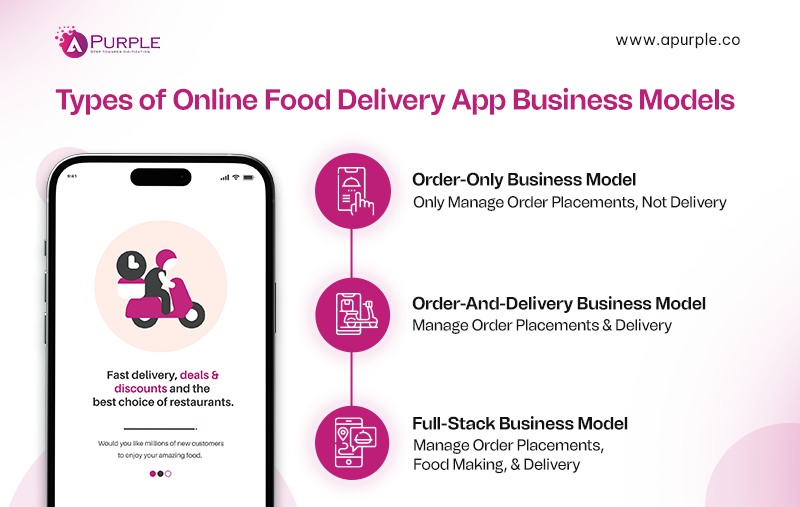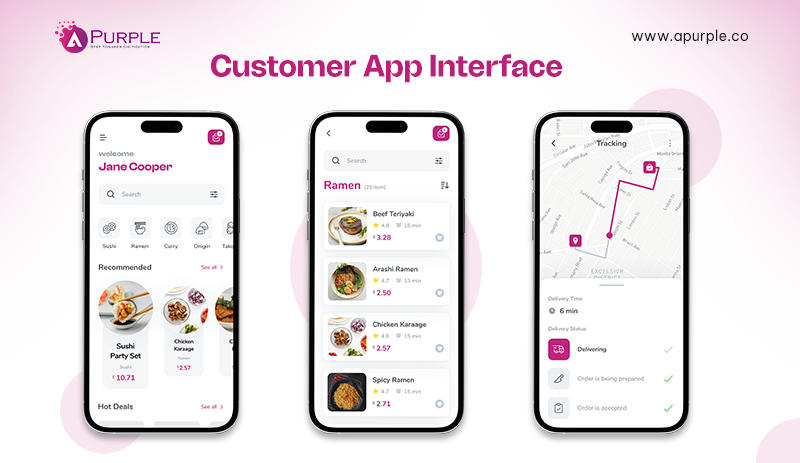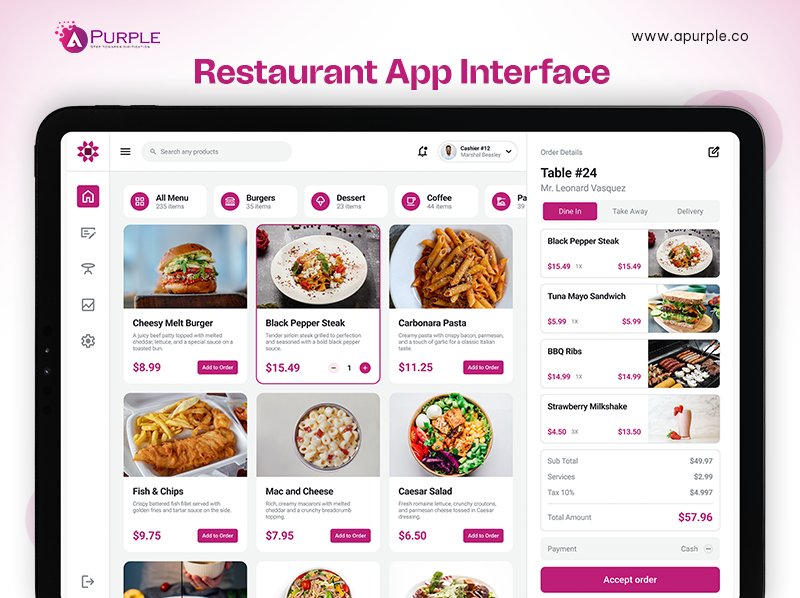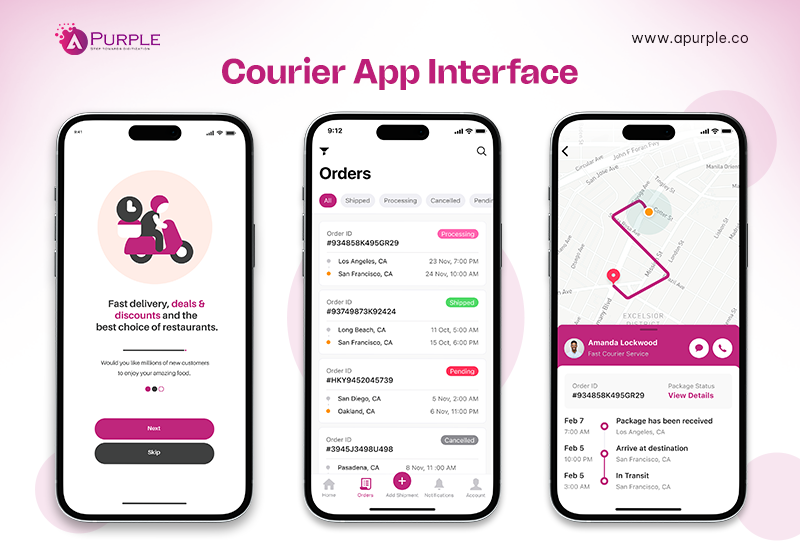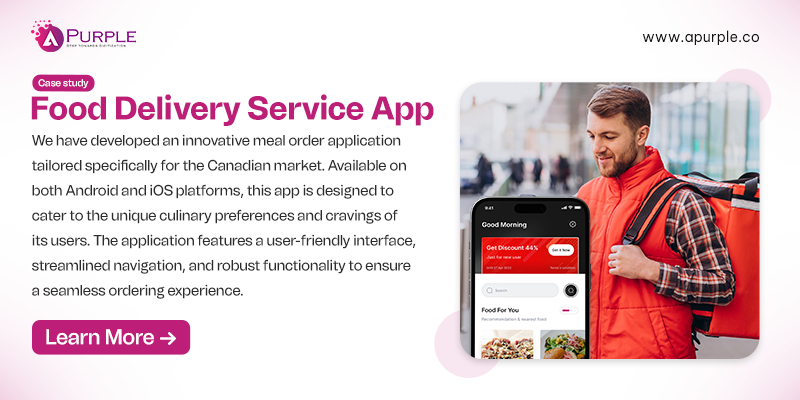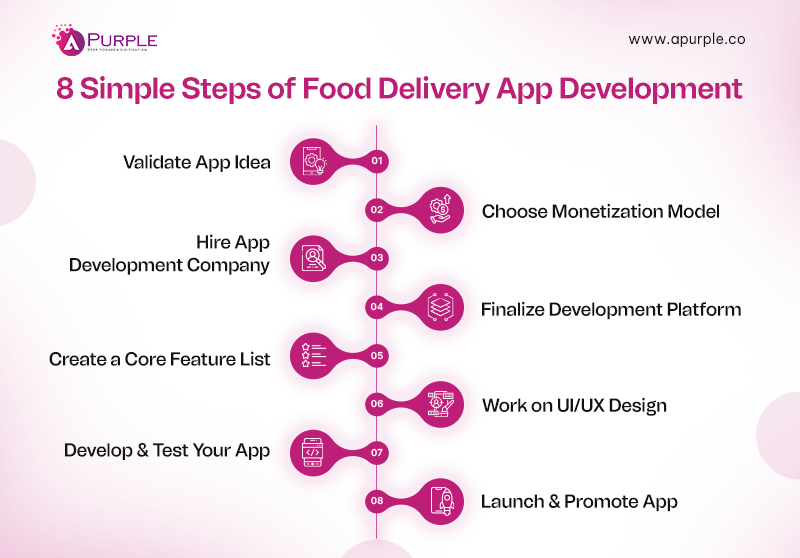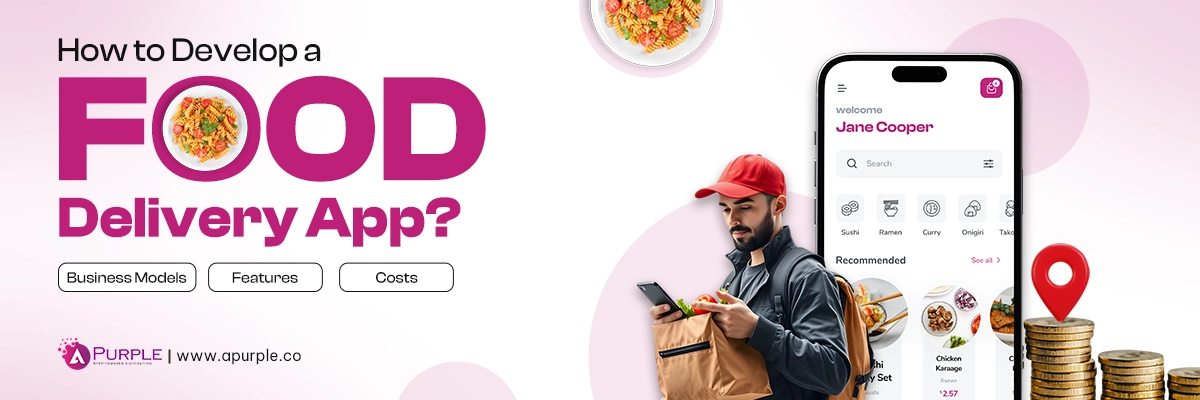
Food delivery apps have become a big deal. People prefer the convenience of ordering food online from a wide range of menu and restaurant options instead of wasting time dining in or waiting in long drive-thru lines. As a result, the online food delivery market has exhibited a CAGR of 8.5% from 2026 to 2029 and is projected to reach a global market volume of approximately 1.89 trillion U.S. dollars in 2029. That’s huge!!
Because of the projected growth, many traditional food establishments are moving online with food delivery app development to expand their customer base. If you are not planning to do the same, you’ll stay behind in the competition. However, if you are planning but don’t know where to start, don’t worry. aPurple is here to help.
We have compiled this guide to help you understand the right flow of food delivery app development, the technology used in it, essential features to include, food delivery app development cost, enterprise and startup business models, and how food delivery apps make money.
Whether you are a startup, restaurant owner, retailer, food vendor, or aggregator, investing in food delivery app development solutions will bring you a high return on investment.
What is a Food Delivery App? Why it’s in the Buzz?
A food delivery app is a bridge between customers and food establishments (restaurants). This mobile application directly connects customers to restaurants, giving them the convenience of being at home or away from restaurants. Users can browse menus, place food orders, and make food payments – everything on their mobile phones.
On-demand food delivery app development (a mobile app that allows customers to order food from restaurants and have it delivered to their place) provides convenience, variety, and multiple offers to customers. With food delivery apps, food establishments can reach more customers, drive sales growth, and scale their branding initiatives.
The reason why food delivery apps are huge right now is because the online food delivery market size has increased tremendously at the global level. In 2026, it is forecast to reach over 1.48 trillion U.S. dollars, and then with a CAGR of 7.79%, it will reach 1.85 trillion U.S. dollars market volume by 2029. In it, the grocery delivery sector is projected to generate 0.94 trillion U.S dollars in 2026. At the same time, the meal delivery sector is estimated to reach 2.5 billion users by 2029.
So, if you have been noticing the sudden jump in business owners rushing to have grocery app development or food delivery app development done, it’s largely influenced by the quick commerce trend — where speed and user experience define success. Below mentioned are some of the most popular food delivery apps for you to take inspiration from. They were once startups that have now grown exponentially and are revolutionzing the food delivery industry.
Top Examples of Successful Online Food Delivery Apps
| Food Delivery App Examples | Key Features & Capabilities | App Platforms | Number of App Users |
|---|---|---|---|
| DoorDash |
|
iOS and Android | 37 Million Monthly Active Users |
| Uber Eats |
|
iOS and Android | 88 Million Users |
| GrubHub |
|
iOS and Android | 33.8 Million Users |
| Postmates |
|
iOS and Android | 9.3 Million Monthly Active Users |
Online Food Delivery App Business Models: How It Works?
As a startup, if you are planning to launch a business in the food delivery mobile app development sector, then you must decide which business model fits your current circumstances. Knowing the flow and detailed factors of every food delivery business model, you can identify which model best fits your food business idea. Let’s explore.
1. Order-Only Business Model OR Platform to Customer
In the order-only food delivery business model, you develop a food delivery app that connects your customers directly with multiple restaurants, food providers, or retail stores in their nearby area. By exploring a variety of restaurant menus, consumers can place an order through your food delivery mobile application. However, your platform is not responsible for managing the food delivery. Whenever an order is placed, the respective restaurant or retailer will ensure the proper delivery at the user’s location.
Here is the typical order workflow of order only business model:
- The user browses local restaurants and food providers using your food delivery application.
- They select items they want to order and then place a successful order with complete payment.
- The restaurant receives an order and prepares the food.
- After the food packing, the restaurant aligns the delivery task with their internal employee or third-party delivery company.
- The delivery person completes the task by bringing food to the customer’s location.
Examples: Popular food delivery mobile applications like Grubhub, Seamless, Foodpanda, etc., follow order-only business models.
2. Order-And-Delivery Business Model OR Delivery Service Aggregators
The only difference in the order-with-delivery business model is delivery of any meal is managed by the food delivery app platform instead of restaurants or retailers. That means, unlike the order-only model, where the restaurants are responsible for managing food deliveries, you are the one who handles order placements as well as the order delivery.
Have a look at the steps involved in the order-and-delivery model:
- The customer explores multiple local restaurants through your food delivery mobile app.
- A customer likes the food, selects the food, and pays for the food to successfully complete the order.
- The restaurant is notified to prepare food for the respective order.
- After that, the restaurant packs the food properly.
- The associate delivery person with the food delivery mobile app picks up the order.
- Then, the delivery person reaches the customer’s location and delivers the food.
Examples: Uber Eats, Swiggy, etc., are famous food delivery applications that have opt order-and-delivery business models.
3. Full-Stack Business Model
In the full-stack business model, you develop a food delivery app, take orders through the app, prepare the food, and deliver it to the customer’s location. This means you have to manage every aspect of food delivery services rather than relying on third-party delivery partners or restaurants.
For the successful implication of a full-stack business model, you have to do more than just make a food delivery app and manage delivery. You need a cloud kitchen or ghost kitchen for preparing the meals. If you proceed with this business model, you will need cloud kitchen app development services.
Check the workflow of a full-stack business model:
- The customer will explore an in-app food menu to decide what to order.
- A Customer selects the food and pays for their order.
- After the order is placed, the cloud kitchen will receive a notification for food preparation.
- An order is handed over to the delivery department once the food is prepared and packed under your banner.
- Your associate restaurant’s courier or delivery partner reaches the customer’s location and delivers the food.
Examples: Deliveroo, Doordash, etc., have chosen a full-stack business model to mark their name in the online food delivery industry.
Expert Advice
All this says, if you are a startup or small business with limited investment, then you can first start with the order-only business model, and later, you can expand your business by implementing an order-with-delivery or full-stack business model. Enterprise-level firms or companies with large investments can opt for any business model with great development, implementation, and marketing strategy.
What Are the Ways to Make Money with Food Delivery Mobile App Development?
Before moving forward with the food delivery application development, it’s important to pre-decide the monetization plan. Check out classic approaches to making money through custom food delivery application development.
1. Delivery fees
When you build your own food delivery app, charging for delivery services is one of the straightforward ways to make money through the platform. This can be your source of revenue as well as give assurance that additional costs incurred with the driver are sufficiently covered.
You can try to acquire money as delivery fees by approaching these two ways:
- Apply flat fee as delivery charges, but you need to define the maximum range of delivery area – it helps in compensating delivery persons.
- Another way is to set dynamic delivery fees that will vary depending on the distance between a customer and the restaurant (you can consider other factors like traffic conditions, road conditions, weather conditions, day or night timelines, etc.)
2. Service fees
The service fees for using the food delivery app could be charged for listed restaurants as well as for the customers.
- For restaurants, deduct commission on every food order based on a percentage of total meal value (delivery charges are not included).
- With customers, you can charge premium service fees like extra charges on preferred delivery on busy times, advance feature access, 10-minute delivery service, etc.
3. Sponsored In-app Ads and Promotions
Another way of generating revenue through custom food delivery application development is to provide promotion and advertising opportunities within the app. For example, take fees or charges from restaurants and food providers to promote and advertise their restaurants by giving direct suggestions to customers’ feeds, boosting ranking in restaurant listings, and showing restaurant banners at the top of the app.
Must-have Features to Develop Food Delivery App
There are four major roles involved in who uses food delivery apps to fulfill requirements of food orders. Customer panel, restaurant panel, delivery partner (courier) panel, and admin panel are the types of panels you need to create with mandatory features. We have categorized all these panel features under food delivery mobile app development. Check here:
1. Customer Panel Features in Food Delivery App
It’s crucial to ensure that customer food delivery app design is initiative and user-friendly with essential features and functionality because whenever a customer places an order, you get close to achieving your targeted ROI. To build from scratch or clone app like UberEats, you have to ensure the following features in the customer panel development of your food delivery app.
- Registration and Login: Customers can register their account with email addresses and passwords or directly log in with Gmail or popular social media platforms like Facebook and Instagram. Alternatively, you can set mobile number login with a one-time-password (OTP) for authentication.
- User Dashboard: The user dashboard has highlights of each restaurant in a well-organized manner.
- Restaurant or Item Search: This feature is generally located at the top of the user dashboard. With this search feature, customers can easily search for their cravings and favorite restaurants or food providers.
- Map Feature: With the list of nearby restaurants, it’s essential to provide a map feature so users can explore restaurants or locations.
- Shortlisted Items: While browsing food, shortlisting the food items makes the food delivery app more intuitive. Customers can change the item quantity or modify the final order.
- Restaurant Menu: After selecting a restaurant, customers are expecting the menu. That’s why providing a variety of food options with images and customer feedback is essential.
- Food-Delivery Pickup Location: The user should have an automatic GPS-enabling feature for address optimization, the facility to insert address details manually, or set pickup location directly on the map.
- Payment Modes: Giving a compulsory payment option is not a good idea. Users must be provided with multiple payment options such as cash on delivery (COD), debit/credit card, net banking, or through payment gateways.
- Offers, Discounts, And Best Deals: By using push notifications, the restaurant owners update customers regarding their discounts, new offers, and best deals on foods.
- Ratings & User Reviews: Allow users to check food and restaurant ratings, reviews & feedback before making a final order.
- Contact Information: Providing detailed contact information of restaurants, including phone numbers, email, and addresses, is good for earning the trust of your customers.
- Order Tracking: Setting up a convenient way of tracking the real-time status of their order helps customers estimate the arrival time.
2. Restaurant Panel Features in Food Delivery Application
The restaurant food delivery app development is all about getting notified when an order is placed, accepting the order, and managing menus. You need to create user-friendly features and listing functionality in your online restaurant UI/UX app design, so the restaurant owners can manage their accounts efficiently. Check the following features for the restaurant panel.
- Restaurant Registration & Login: Similar to the customer panel, restaurant owners are also required to complete the registration process with their email, phone number, or social media account. But with that, they also have to submit additional documents to verify the reliability of their business. After successful registration, restaurants can easily log into their accounts anytime with registered user IDs and passwords.
- Restaurant Dashboard: After successfully setting up a restaurant account, owners are directed to the app dashboard. This screen shows comprehensive information on the total number of received, pending, and delivered orders.
- Order Information: Restaurant owners must have full access to order details. Also, they have the right to decline any order request in case they cannot fulfill the requirements due to the unavailability of raw materials, resources, or any other circumstances.
- Account Management: Regarding the restaurant name, logo, contact information, food images, minimum order quantity (MOQ), food pricing, operating hours, delivery locations, and delivery fees (if applicable), restaurant owners have full access to update whenever they want.
- Menu Management: Restaurants should have full rights to change or modify food menus & their pricing according to their feasibility.
3. Courier Panel Features in Food Delivery Mobile App
For fast and seamless delivery, check out crafting the following features in the delivery partner panel under on-demand food delivery app development.
- Login: To use a feed delivery app, the login credentials are given by the admin to the delivery partner.
- Order Request: Whenever the customer places an order successfully, it is automatically assigned to the delivery partner with necessary information like customer name, address, contact number, and order ID.
- Food Order Delivery Live Status: This one is for restaurant owners and customers on behalf of the courier panel to track the live status of their order. They can watch if the order is in preparation mode or on the way to delivery.
- Order History: Delivery personnel can evaluate their past orders and pending orders under the order history feature.
- Map Navigation: The Google map navigation feature helps a lot to react to the right destination on time. Delivery partners can make fast and seamless delivery with proper navigation.
4. Admin Panel Features in Food Delivery App
If you are the one who is making a food delivery service app, then the admin panel is for you. It is the control center of the whole online food delivery process through the app. Check out the mandatory features for better order management and smooth deliveries.
- Data Control: Admin has full control over all the data placed in an application. They can see the user list, add new users, and edit or remove users. Even information like total orders and earnings are accessible to the admin panel.
- Add/Block Access (Restaurant Manager): The admin can completely access the restaurant profile. They have the authority to add, remove, block, or edit any restaurant account. Also, features like discount coupons, promo codes, etc., are managed with an admin panel.
- User Analytics: Admins can analyze the real-time actions made by users. To increase user engagement and product life-cycle, admins can collect, visualize, and review the user data.
- Payment Management: With this feature, admins can change delivery fees anytime they want.
Unique Food Delivery App Developed by aPurple
Tech Stack Required for Food Delivery Application Development
To build a successful food delivery mobile application or clone app like DoorDash or Uber Eats, it’s important to know the technology used behind it.
Here is the tech stack guide to choose the best for your custom food delivery application development:
1. Technology as Per the Type of App Development
| App Type | Tech Stack Used |
|---|---|
| iOS Mobile App Development | iOS SDK, Swift |
| Android Mobile App Development | Android SDK, Java, Kotlin |
| Hybrid Mobile App Development | Flutter, React Native, Ionic, etc. |
2. Other Essential Technologies Under Food Delivery App Development
| Categories | Tech Stack Used |
|---|---|
| Programming Languages | HTML, CSS, JavaScript |
| Cloud Servers | Amazon AWS, Azure, Google |
| Database | MySQL / MongoDB / PostgreSQL |
3. Backend Technologies Required for Food Delivery App
| Categories | Tech Stack Used |
|---|---|
| Programming Language | PHP, Python |
| Framework | Symfony, Django |
4. Necessary Third-party Integrations with Food Delivery Mobile App
| Integration Type | Tech Stack Used |
|---|---|
| Payment | Braintree, PayPal, Stripe |
| Geolocation | Google Spaces APIs |
| SMS | Twilio |
| Analytics | Google Analytics, Mixpanel |
How to Develop a Food Delivery App? Build an App Like Grubhub, UberEats, & Glovo in 8 Simple Steps
If you are looking for a simplified food delivery app development process, then just consider the steps listed below:
Step 1: Check the Feasibility of Your Food Delivery App Idea
Directly jumping on food delivery application development becomes one of the business mistakes and causes you time, money, and financial damage. Do thorough research and decide what you actually want to build: Do you want to make an order-only solution or focus on a particular restaurant?
With pre-research, collect user data, understand their behavior, and analyze the latest trends. Competitor analyses will help you to identify the strengths and weaknesses of your app idea. Also, use this gap analysis to create a strategy that differentiates your food delivery service in the industry. This way ensures that your app will fit in the market and give you the opportunity to earn profit.
Step 2: Choose Your Monetization Model
The right monetization model is crucial to building a successful and profitable business. If you choose an appropriate strategy for your food delivery app, it will not only help you manage your operational costs but also ensure that you will get a sustainable business with a stable income.
Here are the primary food delivery app monetization models to consider:
- Restaurant Fee: Directly charge restaurants to get listed on your app (you can charge extra for premium listing).
- Commission on Orders: You can deduct some percentage on every order from the restaurants as a platform commission.
- User Fee: With customers, you can charge for deliveries. You can charge fixed money or change fees as the distance varies.
- Subscription Model for Customers: Set subscription fees for customers. They will get free delivery, offers, discounts, and other benefits by making them premium customers.
- Subscription Model for Restaurants: Provide restaurants with varying features and services to register in your app. Take regular fees (monthly, quarterly, yearly, etc.) from them to get listed actively on the platform.
Step 3: Hire an Experienced Food Delivery App Development Company
Partnering with an experienced food delivery app development company like aPurple will guide you throughout the food delivery app development process. Having a good team can drive your business up like a piece of cake. Here are the different ways to choose them:
- Hire In-house Experts: You can build your own team by hiring experts of each category to fulfill your food delivery app development dream. However, this can be a costly option as you need the necessary resources and a full team for every role and responsibility.
- Outsourcing: Only pay for the work you receive by hiring a team of experts from a food delivery app development services provider to build everything from scratch. You can focus on your marketing part as your vendor takes over everything related to food delivery mobile application development.
- Outstaffing: Just hire the only staff that you don’t have to complete your food delivery mobile app development team. Connect with the outsourcing app development company to hire a food delivery app developer who works as a part of your internal team.
Step 4: Finalize the Development Platforms and Tech Stack
You have to clarify the platform type and app technology you want to utilize before starting a food delivery app development. Consider the following points to decide whether your app will be a native, web-based, or hybrid app.
- Native Apps: Native application development targets mobile platforms like iOS and Android specifically, offering the best user experience and performance — though it can be costly in terms of development and maintenance.
- Web-based Applications: Web apps are accessible in browsers, and there is no need to download them on any device. However, they may have limited functionality as compared to mobile applications.
- Cross-platform App Development (Hybrid Apps): This is the most liked way of developing mobile apps by entrepreneurs. It can develop applications for multiple platforms with a single codebase, ultimately saving time and money.
Step 5: Create Your Food Delivery App Features List
Developing an on-demand food delivery app requires deciding on basic features that will provide the best user experience and smooth functionality. Your vendor can help you finalize the feature list.
The feature and functionality you decide will affect the final cost of developing a food delivery app. Add features considering the basic app requirements of your customers, restaurants, and delivery partners.
Step 6: Work on Intuitive UI/UX Design
Creating a pleasant, attractive, and simple-to-use food delivery app UI/UX design is crucial to providing a better user experience and gaining customer retention. Don’t create complex designs in the myth of giving an advanced and high-tech look; everybody wants easy navigation while using a food delivery app. With your brand’s theme colors, design something intuitive so that customers can place an order quickly and simply.
Step 7: Develop and Test Your Food Delivery App
After the final call on app design, start building your food delivery app. Your hired developers need to do proper coding to integrate the app’s features and functionality. The app must be optimized to ensure faster loading and smooth running capabilities.
You can start with the MVP in mobile app development. By collaborating with an experienced MVP development company like aPurple, you can craft your food delivery app with core features and functionality to get feedback from real users. Considering their feedback, optimize your app and work on developing further features to provide a better user experience.
Even after the development, the app needs continuous testing and maintenance to keep running smoothly. To resolve all the bugs and issues, you need to test your food delivery service app on various devices and operating systems so a large audience can access it.
Step 8: Launch and Promote Your App
Once you have successfully completed the custom food delivery application development, it’s time to launch it. Submit your food delivery app on the relevant app stores like Google Play Store and App Store. Make sure you follow all the guidelines to register your app smoothly and get fast approvals.
Check this video to launch your food delivery app in just 2 days. This video has a proper explanation of the app launching with a live demo. Don’t miss it!!
After making your food delivery app live, put all your efforts into attracting users with increased visibility by implementing a comprehensive marketing strategy. Take advantage of branding service providers, social media campaigns, email marketing, content marketing, influencer collaborations, and targeted ads to enhance the online visibility of your food delivery app. Effective marketing and consistent user engagement are important to build a loyal customer base and raise the number of food delivery app downloads.
Following the above master steps, you can build popular food delivery apps like GrubHub, UberEats, DoorDash, Glovo, Deliveroo, Talabat, HungerStation, GoPuff, etc. Also, you can follow the same strategy for grocery delivery app development. Check the next section to get quick info on the cost of developing a food delivery app.
Food Delivery App Development Cost: Quick Guide
Each and every stage of food delivery app development involves factors that affect the cost of developing a food delivery app. Check this quick guide based on app complexity and popular app examples to get an estimation of food delivery app development cost.
Cost to Develop a Food Delivery App Based on App Complexity
| App Complexity | Food Delivery App Cost | Per Hour Rate | Development Time |
|---|---|---|---|
| Basic Level | USD 18,000 to 30,000 | USD 25/hour | 3 to 4 Months |
| Moderate Level | USD 37,000 to 60,000 | USD 50/hour | 5 to 8 Months |
| Advanced Level | USD 60,000 to 1,00,000+ | USD 150/hour | 9+ Months |
Cost of Developing Food Delivery Apps Like GrubHub, Deliveroo, UberEats, Postmates
| App Name | Complexity Level | Development Cost Range |
|---|---|---|
| DoorDash | Complex | USD 100,000 to 180,000 |
| UberEats | Complex | USD 90,000 to 130,000 |
| GrubHub | Complex | USD 80,000 to 150,000 |
| Instacart | Complex | USD 90,000 to 120,000 |
| Postmates | Moderate | USD 50,000 to 120,000 |
| Deliveroo | Moderate-Complex | USD 60,000 to 80,000 |
| Zomato | Moderate-Complex | USD 40,000 to 70,000 |
Final Words
Jumping into the online delivery service sector through a mobile application needs careful consideration of many factors, as mentioned in this guide. From understanding market trends & target audiences to exploring various ways of monetization models, entrepreneurs have to finalize a lot of things before starting a food delivery app development.
If you are also interested in creating a food delivery app, partner with a trusted and experienced food delivery app development company like aPurple. This way you ensure getting exceptional results with your customized food delivery app development that attracts delight customers and boosts business revenue.
Happy Food Delivery App Development!!
Frequently Asked Questions (FAQs)

